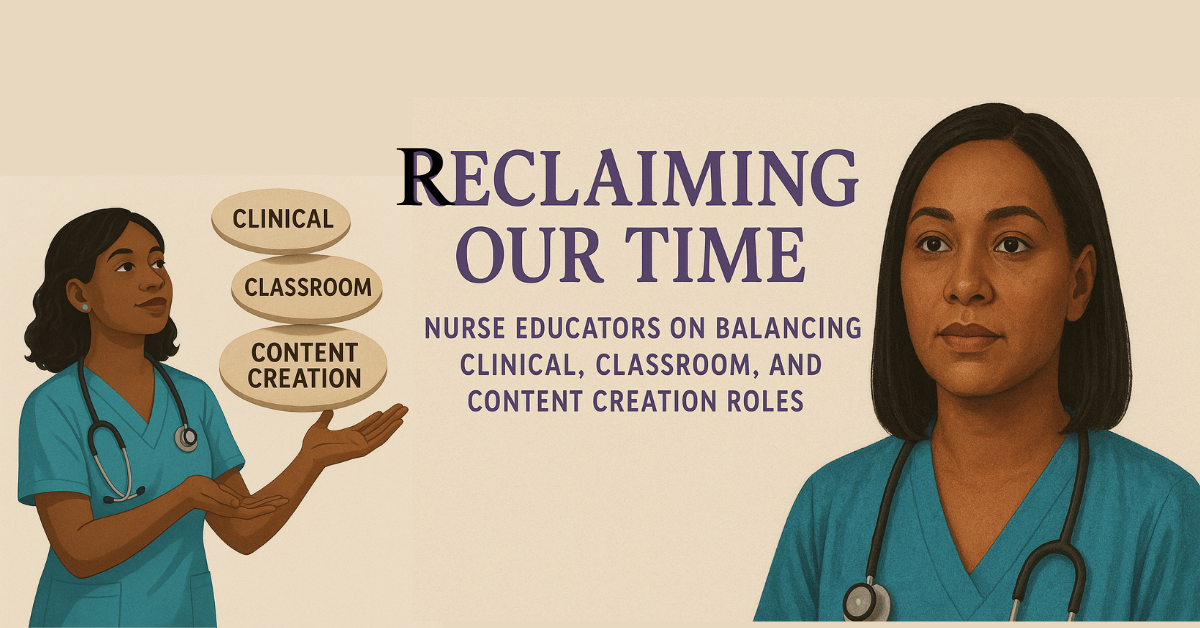The Reclaiming Our Time Nurse Educators on Balancing Clinical Classroom and Content Creation Roles. Nursing educators must balance clinical practice, teaching, and content creation while simultaneously managing their own time and well-being. Many educators find the combination of these roles challenging, but also extremely rewarding. Effective time management, prioritization, and collaboration with other educators are key to reclaiming time and finding a sustainable balance.
Reclaiming Our Time Nurse Educators on Balancing Clinical Classroom and Content Creation Roles
There’s a knowing smile that passes between nurse trainers when someone asks, “So what do you do?” The reply “I teach nursing” hardly gets to the essential job of simultaneously engaging in patient care, classroom instruction, as well as working on digital content. To nurse educators of today who like to wear different hats, it is no longer an unusual but rather a regular occurrence. But it’s also perfectly normal for the same thing to be a significant source of fatigue. However, it is also quite understandable for the same purpose to cause a certain level of fatigue in the person doing.
The Modern Nurse Educator’s Triple Role
The traditional boundaries between clinical practice, academic teaching, and content creation have blurred. Today’s nurse educators find themselves:
- Maintaining clinical skills through direct patient care shifts
- Designing and delivering engaging classroom experiences
- Creating digital learning materials, from lecture videos to interactive case studies
- Adapting content for different learning styles and platforms
- Staying current with rapidly evolving healthcare evidence
And somehow, finding time to breathe between it all.
When 24 Hours Isn’t Enough
“I sometimes joke that I need a time-turner like in Harry Potter,” says Maria, a critical care nurse who teaches undergraduate students while developing a digital course on ECG interpretation. “Monday I’m in the ICU, Tuesday I’m lecturing to 80 students, and Wednesday I’m recording videos until midnight.”
This constant context-switching comes with cognitive costs. Research shows that multitasking between different professional roles leads to increased stress, reduced effectiveness, and ultimately, burnout—a phenomenon all too familiar in nursing education.
Practical Strategies for Reclaiming Your Time
1. Embrace the “Power Block”
Designate uninterrupted time blocks for specific roles. Three hours of focused content creation often yields better results than six hours of fragmented work.
2. Cross-Pollinate Your Roles
When teaching clinical skills, capture high-quality photos or videos that can later become teaching materials. Your clinical insights become classroom examples, which then inform your content creation.
3. Set Boundaries with Technology
Create separate digital spaces for different roles—distinct email accounts, dedicated devices, or simply different browser profiles. This helps maintain mental boundaries between roles.
4. Practice Ruthless Prioritization
Not everything needs your immediate attention. Adopt a framework for determining what truly matters:
- Will this directly impact patient safety?
- Does this align with my core educational goals?
- Can this be delegated or simplified?
5. Find Your Efficiency Sweet Spot
For content creation, identify when you’re most creative and protect that time fiercely. Early mornings might be perfect for clinical documentation, while evenings work better for creating engaging presentations.
The Sustainability Question
The juggling act of modern nurse education inevitably raises questions of sustainability. As one educator put it: “We’re teaching self-care while modeling its opposite.”
Institutions are slowly recognizing this reality. Progressive nursing programs are implementing:
- Protected time for content development
- Teaching load adjustments for those maintaining clinical practice
- Technical support for digital content creation
- Recognition of content creation in promotion criteria
A Call for Realistic Expectations
Perhaps most importantly, nurse educators must advocate for realistic workloads that acknowledge the complexity of their multi-faceted roles. This means having honest conversations about:
- How many hours content creation actually requires
- The cognitive demands of switching between clinical and academic mindsets
- The ongoing professional development needed across all domains
Finding Your Balance
While systemic changes are needed, individual nurse educators can take immediate steps to reclaim their time:
“I had to learn that good enough is sometimes perfect,” reflects Thomas, who teaches nursing informatics while maintaining a part-time clinical role. “I used to spend hours perfecting every slide. Now I focus on the content that matters most and give myself permission to simplify the rest.”
Conclusion
The nurse educator who can efficiently juggle clinical practice, classroom teaching, and content creation is not superhuman. But the strategic use of their time and energy helps them handle their professional and academic duties. Realizing the difficulties that these multiple roles might cause, setting the right limits, and seeking fair working conditions, nurse educators can reclaim not only their time but also their love for the profession.
Moreover, the objective is not only to pull through the juggling act successfully—rather, it is to flourish inside it by being an example for the next generation of nurses on how to balance professional passion with personal wellbeing.
Read More:
https://nurseseducator.com/didactic-and-dialectic-teaching-rationale-for-team-based-learning/
https://nurseseducator.com/high-fidelity-simulation-use-in-nursing-education/
First NCLEX Exam Center In Pakistan From Lahore (Mall of Lahore) to the Global Nursing
Categories of Journals: W, X, Y and Z Category Journal In Nursing Education
AI in Healthcare Content Creation: A Double-Edged Sword and Scary
Social Links:
https://www.facebook.com/nurseseducator/
https://www.instagram.com/nurseseducator/
